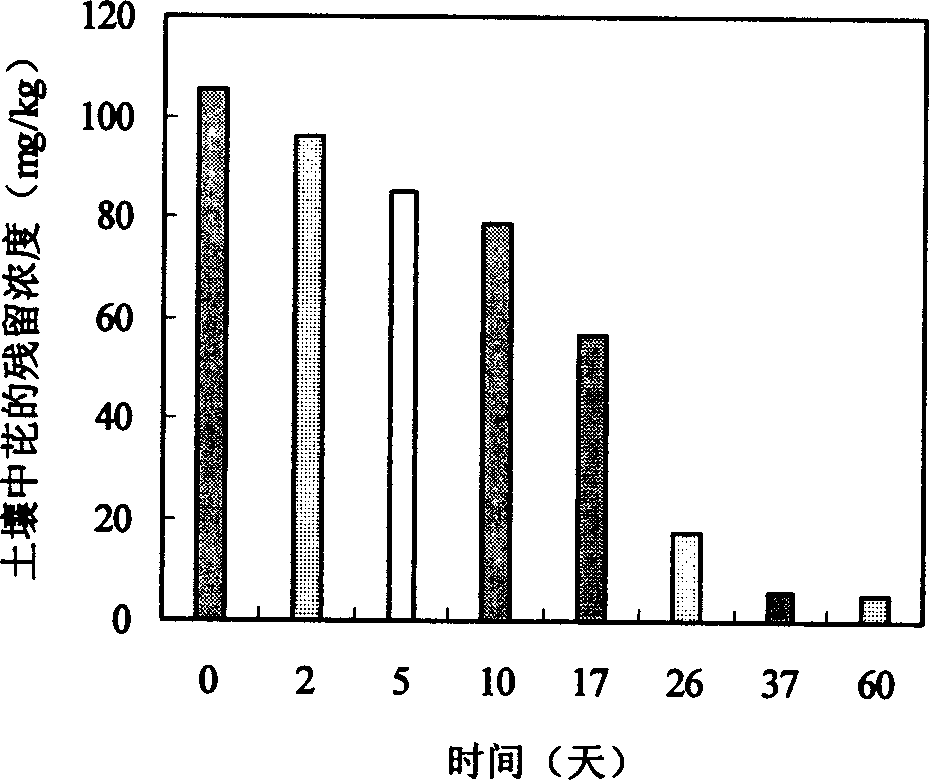Method for restoring soil polluted by polycyclic aromatic hydrocarbon through plants
A technology of surfactants and polycyclic aromatic hydrocarbons, applied in the field of remediation of polluted environments, can solve problems such as low contribution rate, achieve low cost, good remediation effect, and avoid pollution
- Summary
- Abstract
- Description
- Claims
- Application Information
AI Technical Summary
Benefits of technology
Problems solved by technology
Method used
Image
Examples
Embodiment 1
[0017] Embodiment 1: the pyrene-contaminated soil containing pyrene 105mg / kg is ground and passed through a 3mm sieve and placed in a pot, and balanced for 4 days under 50% field water capacity; ryegrass or red clover seedlings are transplanted to pots, After the plant survives, manage it according to the management method of common crops; when the plant grows to a plant height of 10-12cm, apply the non-ionic surfactant Tween80 to the soil, that is, polyoxyethylene (20) sorbitan monooleate Solution, the application rate per kg of soil is 100mg (concentration × volume); after 50 days, soil and plant samples are collected, and the content of pyrene in the soil is analyzed to evaluate the restoration effect.
[0018] After the soil sample is collected, pass through a 20-mesh sieve, weigh 2g into a glass centrifuge tube, add 2g of anhydrous Na 2 SO 4 , fully mixed; after adding 10mL of dichloromethane, ultrasonically extracted; the extract was evaporated to dryness with a rotary ...
Embodiment 2
[0020] Embodiment 2: the pyrene-contaminated soil containing pyrene 105mg / kg is ground and passed through a 3mm sieve and placed in a pot, and balanced for 4 days under 50% field water capacity; ryegrass or red clover seedlings are transplanted to pots, After the plant survives, manage it according to the management method of common crops; when the plant grows to a plant height of 10-12cm, apply the non-ionic surfactant Tween80 to the soil, that is, polyoxyethylene (20) sorbitan monooleate Solution, the application rate is 1000mg per kg of soil; after 60 days, soil and plant samples are collected, and the content of pyrene in the soil is analyzed to evaluate the restoration effect.
[0021] After the soil sample is collected, pass through a 20-mesh sieve, weigh 2g into a glass centrifuge tube, add 2g of anhydrous Na 2 SO 4 , fully mixed; after adding 10mL of dichloromethane, ultrasonically extracted; the extract was evaporated to dryness with a rotary evaporator, and analyzed...
Embodiment 3
[0023] Embodiment 3: the pyrene-contaminated soil containing pyrene 105mg / kg is ground and passed through a 3mm sieve and placed in a pot, and balanced for 4 days under 50% field water capacity; ryegrass or red clover seedlings are transplanted to pots, After the plants survived, manage them according to the management methods of common crops; when the plants grow to a plant height of 10-12 cm, apply non-ionic surfactant Brij35 to the soil, that is, lauryl polyoxyethylene (23) ether solution, per kg of soil The medium application rate is 100 mg; soil and plant samples are collected after 50 days, and the content changes of pyrene in the soil are analyzed to evaluate the restoration effect.
[0024] After the soil sample is collected, pass through a 20-mesh sieve, weigh 2g into a glass centrifuge tube, add 2g of anhydrous Na 2 SO 4 , fully mixed; after adding 10mL of dichloromethane, ultrasonically extracted; the extract was evaporated to dryness with a rotary evaporator, and ...
PUM
 Login to View More
Login to View More Abstract
Description
Claims
Application Information
 Login to View More
Login to View More - R&D
- Intellectual Property
- Life Sciences
- Materials
- Tech Scout
- Unparalleled Data Quality
- Higher Quality Content
- 60% Fewer Hallucinations
Browse by: Latest US Patents, China's latest patents, Technical Efficacy Thesaurus, Application Domain, Technology Topic, Popular Technical Reports.
© 2025 PatSnap. All rights reserved.Legal|Privacy policy|Modern Slavery Act Transparency Statement|Sitemap|About US| Contact US: help@patsnap.com

